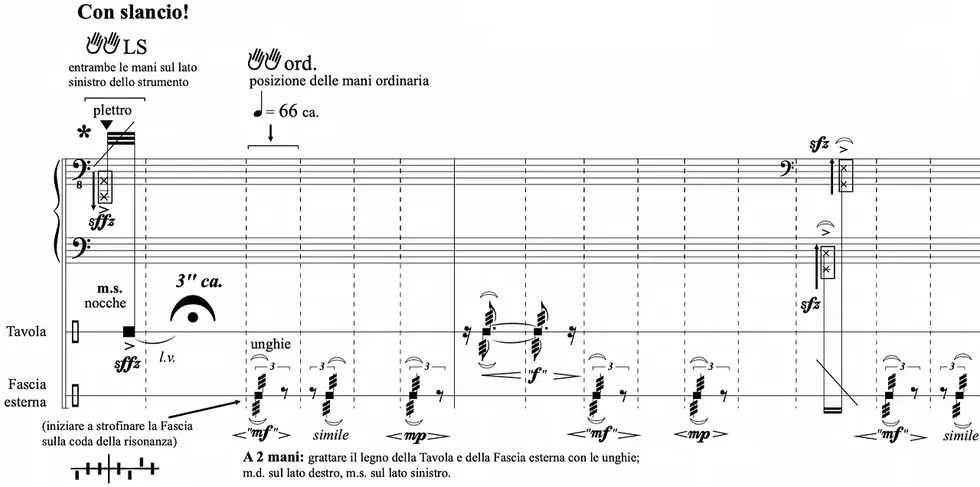Wood, Metal, Strings (2017)
for harp
Duration: 9'
written for Emanuela Battigelli
Premiere: 3 October 2019 - Biennale Musica, Venice

In my most recent works my research has focused on the possibility to make the abstract nature of sound visible and tactile, thus assigning great importance to the gesturality of the performer, who is given the task of giving life and form to a silent material dimension. The expressive power of gestures allows the sound to be seen, as well as heard, and the actual physical presence of the musical instruments acquires a very strong symbolic value similar to that of 17th century still life: it is a presence that shows man the possibility of surviving through art. In Wood-Metal-Strings the exploration of the actual material the instrument is made of, was determinant in the creation of a score that is like a sonic image strongly linked to the different ways of producing sound. The gesturality of the performer was a vivid source of inspiration, and the close observation enabled me to invent a vocabulary that was close to my vision and rich in semantic implications able to capture the attention of the eyes as well as the ears of the listener. At first I tried to have a receptive approach, working a great deal on the timbral characteristics of the different materials together with Emanuela Battigelli. The work was long and complex, but gradually the form came to the surface through sketches, drawings, recordings of sounds and the provisional creation of audio files accumulated during the rehearsals, allowing me to find an answer to the very strong need to be immersed in the sound of the instrument and to learn how to master a particularly rich and fertile material, giving it an almost “organic” form. The strings of the lowest register, dampened with felt, acquire a raucous voice that emits small fragments, nervous and tense, interrupted by brief and evanescent splashes of colour obtained by means of rapid glissandos on the strings of the high register. The ideas are repeated, constantly changing and are recognised by the memory of the listener, who is able to understand its identities, similarities and diversities. The obsessive rhythms of the short initial fragments is associated with different timbres, producing a sonic metamorphosis that involves dampened metal and gut strings, xylophonic sounds on the nylon strings and dense trills on the free strings in the medium-high register. The sounds produced on the strings blend with the constant presence of those produced on the wood of the instrument, sounds that suggest an auditory image linked to a puff of air, a breath, and that cover a very wide dynamic range: from the pianissimo of the soundboard stroked with the palm of the hand or rubbed with the finger tips, to the grating and biting sounds obtained by nervously scratching the surface with the finger nails. On listening to the piece, the sound of the traditional instrument present in the collective memory may prove unusual, but the intention was precisely to create an instrument that would suit my compositional thought of the moment and that, paraphrasing Helmut Lachenmann, could be “original”, being linked to the very roots of the person who produced it.